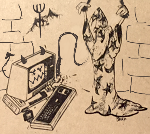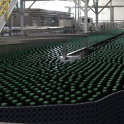|
Mr. Wiggles posted:Hello, homebrew thread. I'm sure this has been answered a zillion times before, but if you would indulge me please. i have no experience with this but I believe lots of folks back-sweeten stuff with something like stevia which adds sweetness but not fermentable sugar.
|
|
|
|

|
| # ? Jun 2, 2024 17:35 |
|
Mr. Wiggles posted:Hello, homebrew thread. I'm sure this has been answered a zillion times before, but if you would indulge me please. How brave are you? Bottle pasteurization is a thing. Very doable if you're safety concious and have a good method.
|
|
|
|
Mr. Wiggles posted:Hello, homebrew thread. I'm sure this has been answered a zillion times before, but if you would indulge me please. Look at potassium metabisulfite (sometimes campden tabs but they can also be sodium metabisulfite), and then leave it to off gas for about 24 hours before bottling. This won't completely kill the yeast, but it's usually good enough. It will also keep your melomel from oxidation, which is why KMS is used in wine making. I wouldn't recommend bottle pasteurization unless you have an immersion circulator, as that will allow you to do it precisely. Pasteurization isn't always great either as it might impact your final flavor too. A non-fermentable sugar substitute is the safest, but only if you enjoy the flavor of it. Or, the very best option is to filter the yeast, but that's tough to control at homebrew scale. Basically, lots of options, none are really the best. Maybe try all three and see which you like the best?
|
|
|
|
Thanks for all the advice, I've got my first brew fermented and despite a bunch of mistakes during the brew it looks/tastes good so far. The problem I'm having now is I cannot for the life of me get a proper siphon going when trying to bottle. I can siphon fine until I start to use the racking cane but when I do the tube fills with air starting at the tube/cane intersection. I'm certain that if I bottle like this I'm going to completely oxygenate the beer. After googling and trying a bunch of things I just gave up and stuck airlock back on but I've already mixed in the priming sugar. Not sure what do at this point.
|
|
|
|
Stoven posted:Thanks for all the advice, I've got my first brew fermented and despite a bunch of mistakes during the brew it looks/tastes good so far. The problem I'm having now is I cannot for the life of me get a proper siphon going when trying to bottle. I can siphon fine until I start to use the racking cane but when I do the tube fills with air starting at the tube/cane intersection. I'm certain that if I bottle like this I'm going to completely oxygenate the beer. After googling and trying a bunch of things I just gave up and stuck airlock back on but I've already mixed in the priming sugar. Not sure what do at this point. You’re supposed to siphon the beer into a bottling pail that has a spigot at the bottom. The priming solution goes into a clean bottling pail and then you siphon the beer into it. Then you hook up a pvc tube with the bottling wand at the end, turn the spigot on and fill your beer with the magic of gravity. Speaking of which I did just that yesterday. Is my beer supposed to look so cloudy in the bottles? I feel like I hosed up somehow. I used a wort chiller and everything when chilling the wort.
|
|
|
|
Kraftwerk posted:
I mean, there might be lots of reasons for cloudyness in beer. For instance I never got my kölsch to clear completely even after 6 months of cellaring, some beer types just don't want to clear always. Give it some time in bottle conditioning and see if that helps. I hear some people chill their bottles to almost freezing to help, others cold crash before bottling. Honestly, I don't worry about it too much, it doesn't affect the taste I don't find.
|
|
|
|
Mr. Wiggles posted:Hello, homebrew thread. I'm sure this has been answered a zillion times before, but if you would indulge me please. I'd second K meta. powder, I've used that for all my wines and never had a problem like you mention. You can mix up a 10% by mass solution in water to make it easier to measure out. If you use potassium sorbate be aware it is intended to be used as a stabiliser with potassium metabisulfite, not by itself. Bottle pasteurisation is possible, I have done it once and it worked fine, but I was scared the whole time that I was about to spray a bunch of glass shards and cider all over the kitchen. I used my electric brew kettle and got the water temperature up to 80C, turned off the heating and put the bottles in for 15 minutes. Remove the bottles (with gloves!) and bring back up to temp for the next batch, repeat until done.
|
|
|
|
Kraftwerk posted:You’re supposed to siphon the beer into a bottling pail that has a spigot at the bottom. The priming solution goes into a clean bottling pail and then you siphon the beer into it. Then you hook up a pvc tube with the bottling wand at the end, turn the spigot on and fill your beer with the magic of gravity. Was it cloudy pre-bottling? And are the bottles chilled or at room temp? Usually the most haziness comes from a chill haze when you cool it down to serving temperature. Some yeast are faster at flocculating than others, I think yeast which attenuate less (i.e. leave more residual sugars) tend to drop pretty clear faster. Less flocculant yeast might be a bit slower.
|
|
|
|
Thanks for the advice on the melomel, everyone. When this crazy exploding fermentation is done I'll see what I can figure out!
|
|
|
|
Kraftwerk posted:You’re supposed to siphon the beer into a bottling pail that has a spigot at the bottom. The priming solution goes into a clean bottling pail and then you siphon the beer into it. Then you hook up a pvc tube with the bottling wand at the end, turn the spigot on and fill your beer with the magic of gravity. Yeah, I'll definitely use a bottling bucket next time. I was following the free version of "How To Brew" and he has both methods in there, but either way I need a proper siphon. I just can't figure out why it wont work, the only thing I've read is height or that it can happen if your siphon tube is too big for the cane but both of those don't apply. I guess I'll pick up an auto siphon when the local store opens back up and try again.
|
|
|
|
Might actually be warm enough to brew this weekend. I'm cleaning all my stuff right now, including some empty kegs that have been sitting in the keezer far to long. The beer lines are looking a little discolored. Replace or just soak them, rinse, and starsan?
|
|
|
|
Does anyone have experience using molasses as an adjunct? Wondering what kind of flavors it imparted post fermentation, and if it was recommended as a fermentable sugar.
|
|
|
|
Did a “wet dry run” of my brewing sculpture setup today now that I’ve got it all together. Used water to test out the pump and hoses and such and no leaks which is nice. Got everything set up with quick disconnects so every hose change comes with a satisfying “ker-chunk”. One problemo is in the sparge arm I’m using: https://www.northernbrewer.com/products/adjustable-stainless-steel-sparge-arm You can see in the pic that it’s got a pretty long metal tube on the top that the hose wraps around. Well that length means that the hose rises up pretty high from the sparge arm, high enough to be partially above the bottom of the hot liquor tank, making it so that the gravity-fed sparge water trickles to nothing with like a gallon and a half left in the HLT, pretty wasteful :/ I can get around this in my setup by having the sparge water travel all the way down to the pump and back up but what’s the point of having a tall brew sculpture if you ain’t taking advantage of gravity?? What sort of sparge arms do y’all use?
|
|
|
|
Also postin' pics of the setup, been using every opportunity to show it off   closeup of the pump/chiller/fermenter stand I made 
|
|
|
|
Not sure what goes wrong with my extract kit beers but all my attempts turned out more of an Belgian Abbey style beer than the style it said on the kit. I think it was 2 blondes, 1 amber and 1 special IPA, but all of them were really dark and tasted like doubles or triples. Not sure if this is an extract kit thing or if I'm doing something wrong (not unlikely although I do try to follow the instructions to a tee). An extract kit porter did come out absolutely amazing. I'm really not a fan of that style and can't say I looked forward to drinking 4 gallons of it. Luckily my dad is a big fan of abbey beers so I just dumped 3 gallons on him. Would've probably be the first homebrew I'd have flushed otherwise. Moving on to all grain (kit) next. Need to plan my next brew day quickly so I can have a nice refreshing saison when spring comes around.
|
|
|
|
Extract (especially liquid extract) will oxidize over time, and if you're buying premade kits from your LHBS, they may have been on the shelf for months. They'll definitely be darker than what you're expecting, and often have more Maillard reaction products (the Maillard reaction is what makes toast different from hot dry bread, or the crusty brown bits on a steak) that can taste maltier, that might be what you're tasting as more Belgian. It also explains why the porter was good -- those flavors complement the dark, malty, roasty flavors better. Using dry malt extract can be an improvement, but yeah, to get beer that tastes the way you want it, all-grain is the way to go. It's seriously not much more complicated than extract.
|
|
|
|
honda whisperer posted:The beer lines are looking a little discolored. Replace or just soak them, rinse, and starsan? If they're stained just get new ones. I replace my lines once a year no matter what, even with a four tap kegerator it's cheap and easy enough to do. LochNessMonster posted:Not sure what goes wrong with my extract kit beers but all my attempts turned out more of an Belgian Abbey style beer than the style it said on the kit. I think it was 2 blondes, 1 amber and 1 special IPA, but all of them were really dark and tasted like doubles or triples. Not sure if this is an extract kit thing or if I'm doing something wrong (not unlikely although I do try to follow the instructions to a tee). An extract kit porter did come out absolutely amazing. Usually when people complain about their beers tasting Belgian no matter the style it has to do with poor handling of yeast, generally cell count and temperature control. If you're using liquid yeast making a starter can help if you happen to be getting old yeast or are making beers above 1.044. Make sure you pitch your yeast at the temperature you want to ferment at, not pitching warm and letting it cool to fermentation temps. The other big thing is temperature control, you need to make sure your beer is fermenting within the temperature tolerance of your yeast strain. A lot of people see a yeast likes a range of 68-72*F and throw it in a 70-72* room and call it a day, but the activity of fermentation can heat your beer 2-6*F above ambient. Get one of those stick on thermometers for your bucket or carboy and keep an eye on it. If you have trouble keeping your beer below 70* most american and english ale strains will throw a lot of esters and phenols you aren't looking for. If thats the case you can either build some kind of temperature controlled fermentation chamber or start using yeasts that have a higher temperature range. Theres a lot of interesting kviek yeasts out now that will ferment clean even very warm and can put out good american style beers at very high temperatures.
|
|
|
|
The kits were all a few months old so I'm sure some oxidation will have taken place. Never heard of the Maillard reaction before, but that's pretty likely one of the reasons by the sounds of it. I've done a all grain brew for an Irish Red before and this didn't have the issue either, so that's in line with the theory. As a fairly new brewer I don't have any temperature control so that could also have been a factor. Haven't ever pitched warm, always at fermentation temperature. Fermenting has always happened at room temperature which has been around 65-68, especially the last one which I brew in November. Several others could've gone up to 70 degrees but probably not much higher than that. I was aware that temp control is important for consistent brewing, but I didn't realize that brewing a few degrees higher could lead to a consistent off flavor like I've been experiencing. Creating a fermentation chamber out of a fridge with a brew pi has been on my mind for some time so that's probably the next step I'll have to take to get some decent tasting beers. Or brew stouts/porters for the rest of my life, which is something that I'd be totally ok with.
|
|
|
|
I'm in the northeast and my basement is always below ferm temps. I wrap a seed mat around my fermenter and then tape my inkbird to the fermenter, and then a blanket around everything to keep some of that temp in. I set my inkbird to 1° differential. My beers usually come out as expected with the yeast. All in it's like $60 bucks as the inkbird controllers are usually on sale regularly. Yeast generally have a narrow range of temps that they work well in, and generally the higher in that range they are the more esters you get. (See yeast package for details)
|
|
|
|
Pillow Armadillo posted:Does anyone have experience using molasses as an adjunct? Wondering what kind of flavors it imparted post fermentation, and if it was recommended as a fermentable sugar. Radical Brewing has some notes on molasses, and a recipe:  
|
|
|
|
Fortaleza posted:Also postin' pics of the setup, been using every opportunity to show it off This is really cool FYI! It certainly humbles my set up of hauling a couple of pots and my Igloo cooler mash tun out to the garage lol
|
|
|
|
Pillow Armadillo posted:Does anyone have experience using molasses as an adjunct? Wondering what kind of flavors it imparted post fermentation, and if it was recommended as a fermentable sugar. Yup, I use it in my Baltic porter. I use original molasses though, not black strap. I mean, it added a hint of molasses flavor to the beer... which is what I was going for. And as far as I can tell, the yeast didn't seem to mind it as a fermentable.
|
|
|
|
When this melomel is done I'm totally making the pirate beer. Thanks for that recipe!
|
|
|
|
Thanks for the leads! Ended up ordering a copy of Radical Brewing. Was aiming to add it to the boil with an experimental wheat beer for some rum-like flavors. Might be a dead end idea for the style, but I'll chime in a few weeks from now with the results.
|
|
|
|
Pillow Armadillo posted:Thanks for the leads! Ended up ordering a copy of Radical Brewing. Was aiming to add it to the boil with an experimental wheat beer for some rum-like flavors. Might be a dead end idea for the style, but I'll chime in a few weeks from now with the results. By all means, experiment with molasses, I certainly don't want to discourage you from that, but: one of the cool things about home brewing is you can do things that are illegal (in the US anyway) for commercial brewers, like just adding rum to your beer. The only reason you don't see beer with rum added on the shelf is that it's illegal, but if you want to make a beer with rum flavor (or wine, whiskey, gin, tequila, etc), you can just add it after primary. No one can stop you.
|
|
|
|
Has anyone used one of the Big Mouth Bubbler EVO 2 siphonless carboys with the tap? Is the tap system easy to clean? thinking I may get set up for kegging and that seems like a nice option especially for the primary
|
|
|
|
I haven't used those, but I've been using the (now mostly defunct) Better Bottle carboys with their proprietary tap system for 90% of my batches. When I need more headspace or something, I also use a 7.9gal bucket with a standard spigot on it. They're pretty easy to clean, and you can always remove them and soak them in PBW or whatever if you suspect they're getting some gunk trapped somewhere.
|
|
|
|
Newbie checking in! A few years ago I bought an extract brewing kit and supplies from my local homebrew store, but then I moved and some stuff got lost and everything got shuffled to the wayside before I had a chance to brew anything. Queue recent drinking and talking about it and tl;dr gonna have some friends over next weekend and brew our first batch! I picked up the latest edition of the Joy of Homebrewing and once that comes in I’ll flip through that  Are there any pitfalls or lessons learned from your guys’ experience that would apply to a first timer using a simple extract kit? Eg gear you wish you’d have bought upfront or rookie mistakes to avoid?
|
|
|
|
OSU_Matthew posted:Newbie checking in! A few years ago I bought an extract brewing kit and supplies from my local homebrew store, but then I moved and some stuff got lost and everything got shuffled to the wayside before I had a chance to brew anything. Keep calm, don't worry, and have a homebrew is the best advice I can give you.
|
|
|
|
OSU_Matthew posted:
Don’t walk away when it’s about to start boiling. It will boil over on you, but if you’re there you can manage the heat and sneak up past the hot break. Hops can also cause this at the beginning of the boil, so it’s cool to back off the boil to control the foaming. Otherwise, relax and have fun, and don’t drink too much until after you’re done with boiling sugar filled liquids.
|
|
|
|
Update on my home brew after bottling. The bottles no longer appear cloudy. They’re almost crystal clear at this point. There’s some weird strands of what I presume to be yeast suspended in the middle but I imagine this will fall to the bottom when bottle conditioning finalizes next week. I guess unlike a traditional macro brew this will need to be carefully poured into a glass to avoid disturbing the yeast below it? I’m also worried that I may have incorrectly mixed the priming solution into it. I boiled it with 2 cups of water in a saucepan and 4oz of sugar. But I forgot to stir the whole thing in the bottling bucket until I was half finished. I’m hopeful that because I siphoned at the very bottom of the bucket that this was sufficient enough to mix everything together.
|
|
|
|
Yeah, just yeast that’ll fall out when you chill it. Pour carefully as it’ll pour out yeast from the bottom as you expect. So long as you gently mixed the two liquids of beer and sugar water you should be just fine on distribution. Any agitation like from putting the rest of the beer into the bottling bucket will help mix it further.
|
|
|
|
OSU_Matthew posted:Are there any pitfalls or lessons learned from your guys’ experience that would apply to a first timer using a simple extract kit? Eg gear you wish you’d have bought upfront or rookie mistakes to avoid? used to brew with my dad like 10 years ago, been meaning to get back into it (hence reading the thread) but here's some random thoughts
Paul MaudDib fucked around with this message at 20:21 on Feb 27, 2021 |
|
|
|
Paul MaudDib posted:
Kegging is life changing and forced carbonation can shave weeks off of the time until your beer hits your glass.
|
|
|
|
Nth Doctor posted:Kegging is life changing and forced carbonation can shave weeks off of the time until your beer hits your glass. this is another thing though, as long as you're not pasteurizing your beer after fermentation, the taste continues to change and mature and age (almost all homebrew is "unfiltered" as craft beers market it). Ideally don't chug it all as soon as it's out of the carboy, ideally you would want to get a rotation going where you give them a few months to age, even in a keg. It will be way better if you give it even a month. Being able to have a taste right away is cool though.
|
|
|
|
the SS Brewtech systems are extremely shiny. What do people think about those / which are the feature increments worth considering? The ones that caught my eye were:
$199 for the basic 7gal brew bucket seems reasonable for a stainless setup, like it's easily possible to spend more than that for a rando brand stainless mash tun. Are they a pain to clean the conical bottom? Does the conical bottom without a drain make it a pain to get yeast out, or is it pretty easy to siphon? They note that the brew buckets are small enough that you can put them in a freezer for temp control, but it seems like to rack them you would have to lift them out and disturb the yeast. How quick does it settle back out (primary fermentation here)? If I wanted to go temperature controlled, the heater/chiller kit is $320 for the Brew Bucket and Chronical while the Brewmaster is $190 (presumably it has the coils already). The 14 gal model is considered a brewmaster edition (LCD thermometer) and only has cooling, that steps to $369 for no temp control and $648 with the cooler. So at that point I think I might as well go for a brewmaster. 14 gal might be tough to move around (that's about 90 pounds of liquid plus 32 pounds for the fermenter), brewing in my garage would be desirable with 14 gal I think. But we have winter here and my garage gets pretty cold, if I throw something underneath it on the concrete to insulate it, is the neoprene jacket + heater going to be enough? or if I wrap it in some additional blankets or something? or is it going to bleed enough heat to be a problem / cause a thermal differential across the liquid? The alternative is to put it in the basement but I won't be able to brew down there obviously, so I'd have to haul the 120 pounds down. I guess I also have a spare bedroom, I could heft it inside and then use a moving cart to move it around the house, but accidents could get messy. Or just not use the fermenter in the winter, but that makes spending $800 a little silly. I also presumably need cooling in my garage in the summer I'd think. The basement stays reasonable in the summer, maybe mid 60s. My garage got below freezing a few weeks ago (blew some soda cans) but normally it's not too bad if you get things off the cold concrete, I normally keep 2 liter bottles in the garage and they're cold or slushy but not frozen. Maybe with a heating jacket I could brew for most of it unless it's a polar vortex? Like I said earlier I used to brew with my dad and several of my favorite beer types are pretty difficult to source locally. I'd like to get a nice setup and run it a lot, with kegs. Probably going to start with a 6.5 glass siphonless for a primary, unless there is some major advantage to a conical stainless setup over glass siphonless? Those should be easy enough to haul down to the basement for fermentation. Then if I want a temp controlled setup, try to figure out how to make the 14 gal chronical brewmaster work? I don't mind $800 on a buy-once cry-once item and a temp controlled fermenter is tantalizing if I can make it work. I already have the functional aspects of a kegging setup minus a chilling mechanism and don't mind doing 10 gal batches. How do you clean a conical fermenter setup where it's on a stand? Garden hose and star san? And the conical bottom, just a nylon bristle brush and star-san? Are the valves any different, flush them with water when you're done and star-san before you fill the fermenter? Paul MaudDib fucked around with this message at 02:18 on Feb 27, 2021 |
|
|
|
Check out anvil. Their 7 gallon buckets are like 129 or less. I love mine. It has a tap.on the side that's hooked up to a racking arm that adjusts so you can keep it out of the trub. Don't use glass it's dangerous. Yeah I just clean mine with a bursh and sanitizer it hot water. tater_salad fucked around with this message at 02:28 on Feb 27, 2021 |
|
|
|
I use the brew bucket exclusively. I have two but haven't been brewing enough lately to put the second one into "production". But they are extremely easy to clean and I like them because of that. I have the brewmaster editions so I can stick a probe in there from my inkbird to control the fermentation chamber. I've been thinking about doing glycol in the future once I finish my brewery build. Look at the Spike brewing flex series. A friend has one and really likes it. I want to say it's a similar price as the brew bucket but with other options. I bought my buckets before the flex system came out.
|
|
|
|
|
tater_salad posted:Check out anvil. Their 7 gallon buckets are like 129 or less. I love mine. It has a tap.on the side that's hooked up to a racking arm that adjusts so you can keep it out of the trub. Glass isn’t dangerous. Putting hot liquids in it is. And moving it while wet can be. Properly using glass is a wonderful thing. Screwing around and acting like it’s not capable of shattering and slicing you up is not. I wouldn’t use it for a general use primary beer fermenter, but I have 5 carboys and they all have good uses. I’m looking forward to filling them all up again soon. I still use plastic buckets for a lot of things. I don’t know that I’d get particularly better results by changing to a conical either. Transferring to a keg “brite” tank for finishing with spunding valve works amazing though, and it lets me dry hop cleanly before transferring to serving keg. There’s lots of ways to do it, and tons of conicals hitting the market. I’d say if you’re doing a ton of modern styles and love US05 then that’s going to be useful. If you’re more into other things, then a conical may not be your best immediate upgrade. Really depends what you’re most interested in doing.
|
|
|
|

|
| # ? Jun 2, 2024 17:35 |
|
OSU_Matthew posted:Newbie checking in! A few years ago I bought an extract brewing kit and supplies from my local homebrew store, but then I moved and some stuff got lost and everything got shuffled to the wayside before I had a chance to brew anything. If your kit tells you to do a "secondary fermentation", ignore it.
|
|
|





































